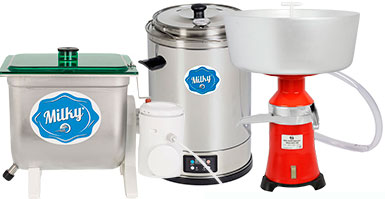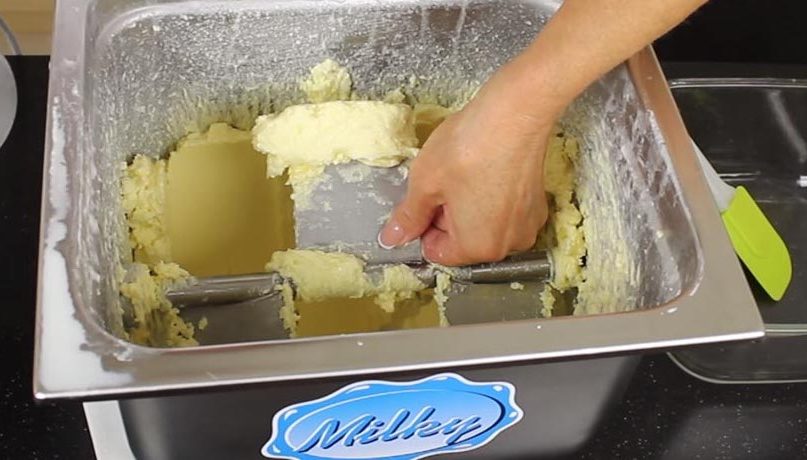Using a butter churn, you can turn cream into delicious homemade butter, ensuring that the quality and taste are exactly what you want. Butter is one of the best things that has ever happened to humanity. It goes with pretty much anything and makes any dish more flavorful. Of course, homemade butter is the best option since you know what’s in it and you can make it taste exactly how you want it to. To make your own butter, you only need one device: a butter churn.
What is a butter churn?
Before getting into the details, let’s first go over the definition of the term. A butter churn is a device that allows you to convert cream into butter. Basically, it churns the cream to the point where it divides into butter and buttermilk.
Thinking of getting a butter churn? Explore our range of these machines — we offer butter churns suited for small to medium farms as well as for home use! If you don’t know which one you should choose, drop us a line, and we will help you make the right decision.
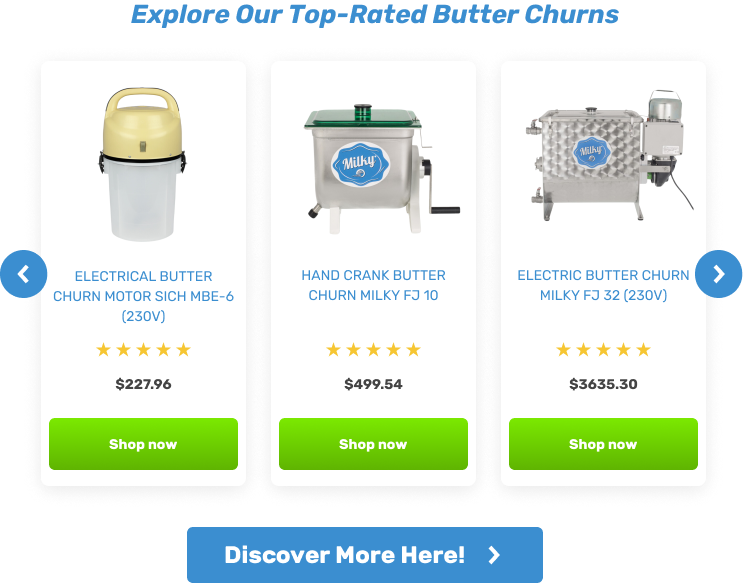
Historians have found evidence suggesting that butter has existed since 2000 BC and the butter churn was created somewhere around 600 BC. The process was quite time-consuming and demanded a lot of dedication. Fortunately, we have different kinds of butter churns today, including electric ones. It’s now much less taxing for us to make some of that delicious product.
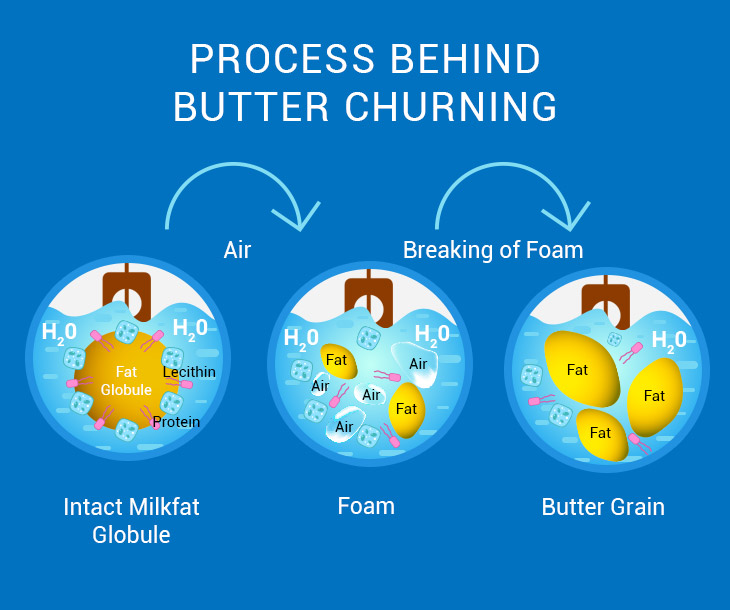
How does it work?
While this is a simple device, we haven’t explained how exactly cream turns into butter. What is the science behind this? Well, it is rather straightforward as well. During the churning process, the cream gets vigorously stirred up. The agitation breaks the membranes of fat molecules, making them clump together. As large clusters of fat collect, they begin forming a network. Also, the churning process generates bubbles of air that trap the liquid and produce the foam separating one substance from another. All this clumped fat is butter, whereas the liquid separated from it is called buttermilk.
Did you know that buttermilk is extremely good for our health? Learn about its benefits from our article.
But how about butter that is made from milk? The truth is that it is not made from milk. Whole milk has to sit until fat molecules float up and create a thick layer on the surface. That’s actually cream that needs to be gathered and then turned into butter through the churning process.
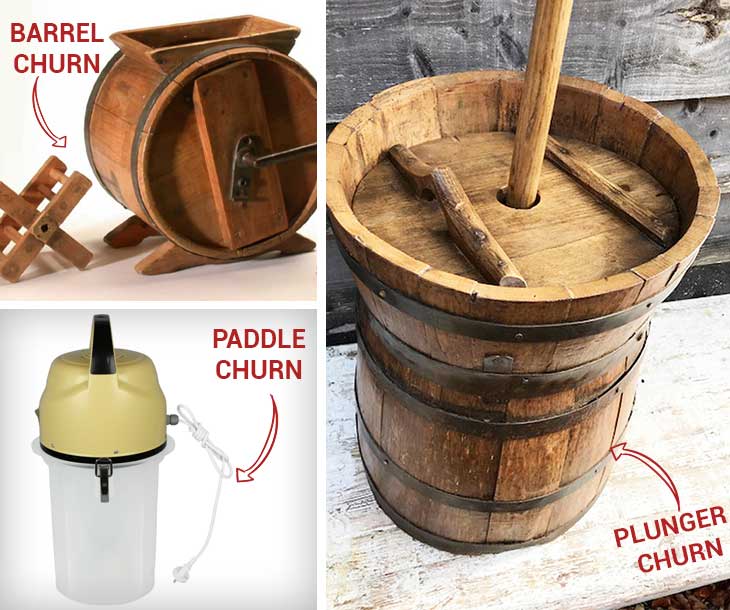
Before making butter it’s necessary to get a cream. The most effective way to do that is using a milk separator. Read How Does a Milk Separator Work?
Types of butter churns
There are different types of churns. Although they work pretty similarly, there are certain differences between them.
Plunger churn
A plunger butter churn is the most historically outstanding type. It often consists of a wooden barrel and a stick that has a disc with holes attached to it. One had to pour milk or cream into the barrel and move the stick up and down inside it for a good 60-90 minutes in order to produce butter.

We’re lucky that technology has evolved enough for us to not have to work with a plunger churn for an hour-and-a-half anymore. Obviously, this type of churn is no longer used. Well, at least not by the masses. Maybe there are still people out there who enjoy the process.
Barrel churn
This is another outdated butter-churning machine. It was widely used in Europe during the 18th century. The mechanism is simple: There is a barrel that one has to fill with milk or cream. The barrel lies on its side and has a handle attached to it. The handle would either turn the whole barrel around or a paddle inside of it. The second option is more modern and is still often used in factories that produce butter.
Paddle churn
This is the most popular kind of churn and is widely used today, especially for homemade butter. Such a machine looks like a container with a couple of paddles in it. They rotate and churn cream, converting it into butter.
Paddle churns can be mechanical or electric. The first kind has a hand crank that one has to rotate manually to make the spread. The second is automatic and powered by electricity. The only thing you need to do is pour cream or milk into the container and wait.
If you would like to know who to make a butter churn at home, read our interview with Brian Johnston, a fourth-generation dairy farmer from Tennessee.
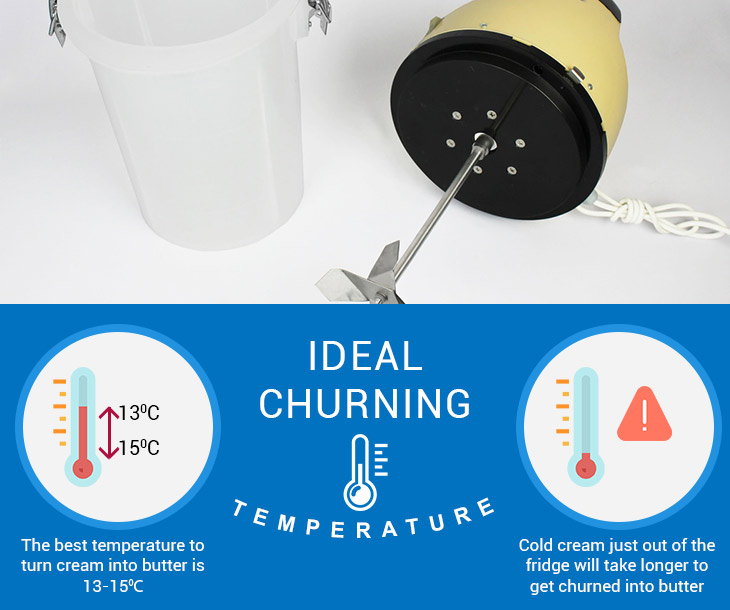
What is the ideal churning temperature?
The best temperature to turn cream into butter is 13-15℃. However, you can work with room temperature as well. Cold cream just out of the fridge will take longer to get churned into butter.
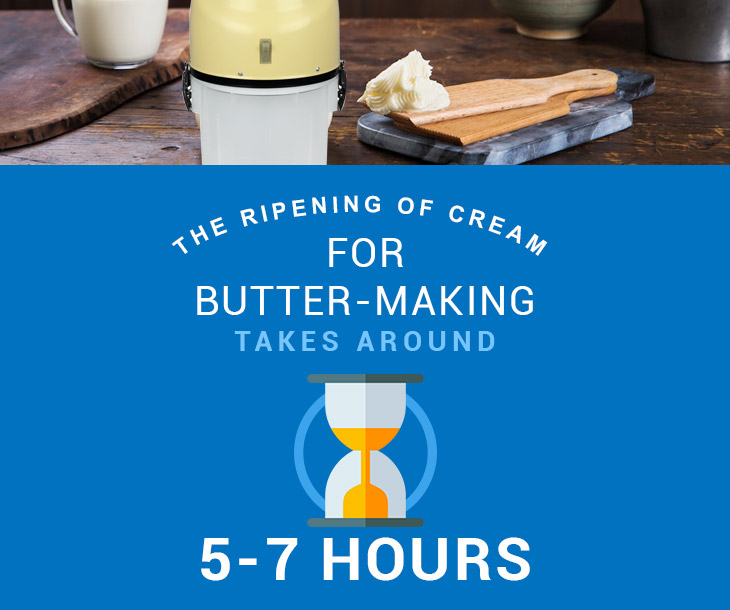
Cream ripening
The ripening of cream for butter-making takes around 5-7 hours. For this process, you only need to leave milk in a container in the fridge so that it doesn’t spoil.
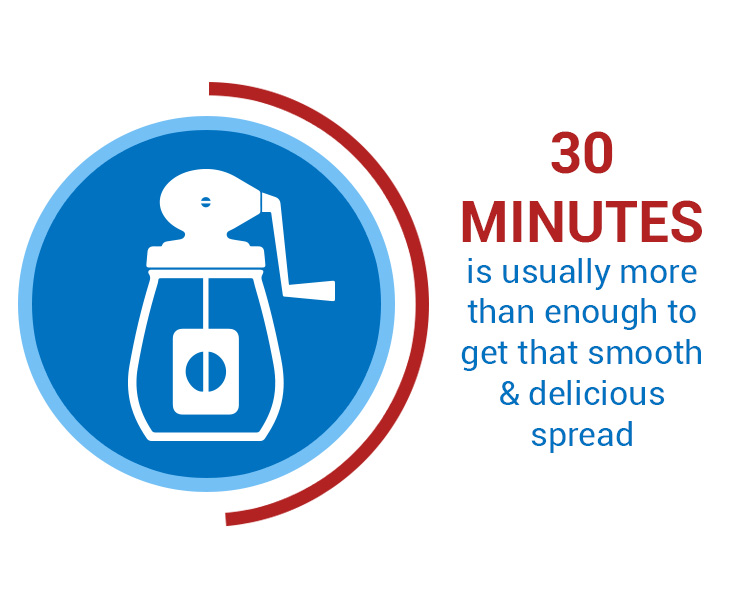
Churning time
How long does it take to churn butter? Not that long. Thirty minutes is usually more than enough to get that smooth and delicious spread.
Fat content in the cream
If you have whole milk, the cream that will appear on the surface is perfect for making butter. But if you want to make it from store-bought cream, look for an option that contains at least 25% fat. Otherwise, you won’t have much success.
Skimmed or whole milk? We’ve research all the advantages and disadvantages of both! Read all the information now to choose milk that fits your personal needs and preferences.
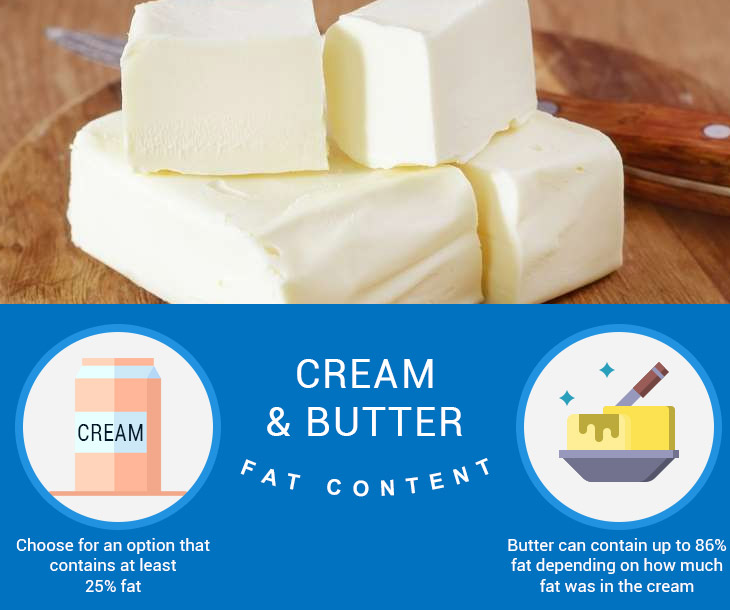
Fat content in butter
If you’re watching your figure, you must wonder how much fat there is in butter since it is even fattier than cream. Butter can contain up to 86% fat depending on how much fat was in the cream. However, you shouldn’t be afraid to eat butter if you’re trying to stay fit. In fact, many experienced dieticians recommend eating around 10 grams of butter every day because it improves digestion.
So enjoy your homemade butter, as you already know what’s in it. You can also twist the flavour by adding other ingredients and spices to it. Experiment and eventually you will learn how to make the perfect butter to suit your taste.
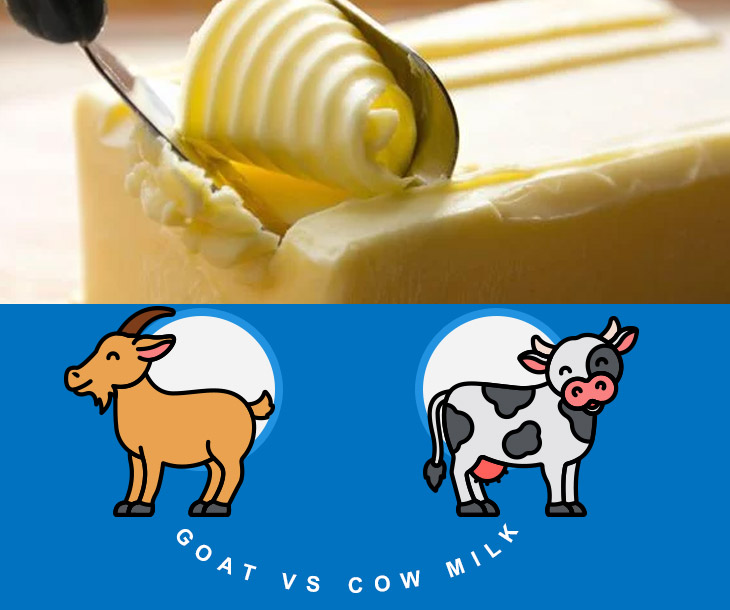
Goat’s vs. cow’s milk
Usually, butter is made from cow’s milk. It is used more often because it is cheaper. Also, it is harder to collect cream from goat’s milk because its buttermilk globules are very small. It can take days for a thick layer of fat to appear on the surface.
Despite that, goat’s butter is just as good if not better than cow’s butter. First of all, it will be much whiter than its counterpart because goats transform beta-carotene into vitamin A in their bodies. That makes goat’s butter much easier to digest. The lower amount of lactose also benefits digestion.
Goat’s butter has a lower melting point and contains more moisture. Therefore, it coats ingredients better, making them taste soft and creamy. Finally, the texture is lighter as well.
But if you don’t like the taste of goat dairy products, this option is not for you. In the end, when it comes to nutritional value, there is not much difference between goat’s and cow’s butter.
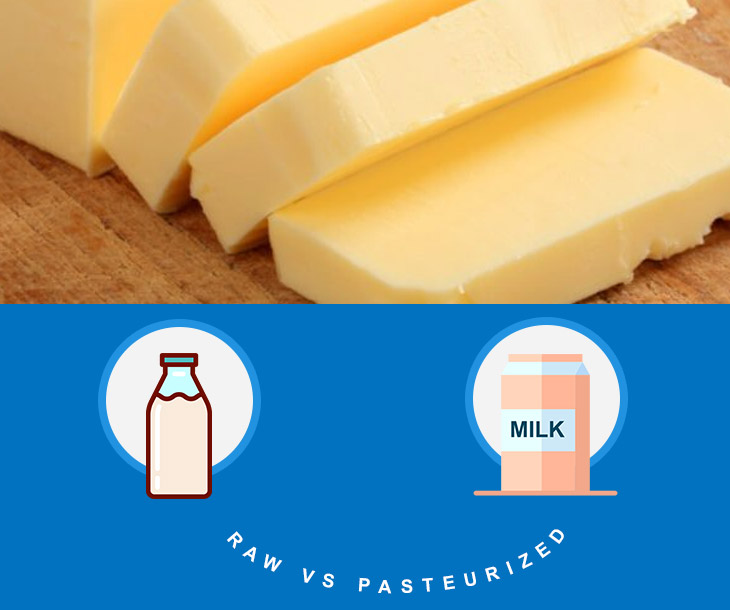
Raw vs. pasteurized
Many people believe that making homemade butter from raw milk is dangerous due to the harmful bacteria that supposedly live in the milk. But if you get whole milk from trustworthy sellers, you can pass on the pasteurized variety.
Killing harmful bacteria can also kill good ones and take away a lot of flavor. Therefore, pasteurized cream and pasteurized butter will be dull and less beneficial than raw butter. Of course, if you’re wary of the bacteria, you can always pasteurize the milk.
Find the right milk pasteurizer for you at Milkyday! Whether you need one for home use or your small farm, we have options for every volume.

Learn more about pasteurized milk to always make a conscious choice!
Congratulations! You are the expert in butter churns now. We hope this article was useful to you. If so, please share it with your friends.
How do you use butter? Share your experience with us in comments below.

